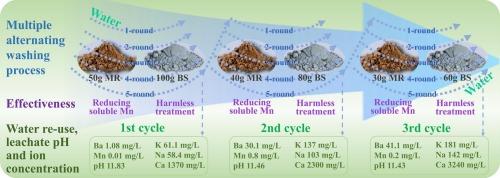Simultaneous harmless treatment of barium slag and manganese residue via a multiple water alternating washing process
IF 7.1
2区 环境科学与生态学
Q1 ENGINEERING, ENVIRONMENTAL
引用次数: 0
Abstract
Barium slag (BS) is a hazardous waste generated during the industrial production process of barium salts, posing serious threats to ecological environment due to its high soluble Ba concentration and high pH. The development of efficient harmless treatment technologies is imperative for BS management. In this study, the Ba dissolution behavior of BS implied that washing with 20 rounds of water could reduce the soluble Ba but cannot achieve harmless treatment. Based on manganese residue (MR) containing soluble MnSO4, an innovative process involving the alternating washing of MR and BS with water, was proposed to simultaneously achieve harmless treatment of BS and reduction of soluble Mn in MR. The conditions used in the process were optimized as follows: MR/BS mass ratio of 50 g/100 g, washing temperature of 25 ℃, washing time of 60 min, and alternating washing for 5 rounds. Under these conditions, treated BS had a Ba extraction toxicity concentration of 25.60 mg/L, decreasing from 1725 mg/L for the original BS, with the pH decreasing from 12.52 to 11.64, and the treated MR had a soluble Mn of 34.20 mg/L from 1900 mg/L of the original MR. Water transferred soluble ions from one waste to form BaSO4 or Mn(OH)2 precipitates, as confirmed by XRD, SEM, and XPS. Additionally, the final washing solution was recyclable for another two water alternating washing processes, with potassium accumulation from 61.1 to 181 mg/L. These findings provide a simple, green, and low-cost technical route for treating BS and MR in production practice.

采用多水交替洗涤工艺对钡渣和锰渣进行同时无害化处理
钡渣是钡盐工业生产过程中产生的有害废弃物,其可溶性Ba浓度高,ph值高,对生态环境造成严重威胁,开发高效无害化处理技术是钡渣治理的迫切需要。在本研究中,BS的Ba溶解行为表明,用20轮水洗涤可以减少可溶性Ba,但不能达到无害化处理。以含可溶性MnSO4的锰渣(MR)为原料,提出了MR与BS交替水洗的创新工艺,同时实现BS的无害化处理和MR中可溶性Mn的还原。优化工艺条件为MR/BS质量比为50 g/100 g,洗涤温度为25℃,洗涤时间为60 min,交替洗涤5次。在此条件下,处理后的BS的Ba萃取毒性浓度为25.60 mg/L,由原BS的1725 mg/L降至25.60 mg/L, pH从12.52降至11.64,处理后的MR的可溶性Mn从原MR的1900 mg/L降至34.20 mg/L, XRD、SEM和XPS证实,水将一个废物中的可溶离子转移形成BaSO4或Mn(OH)2沉淀。此外,最终的洗涤液可回收用于另外两个水交替洗涤过程,钾积累量从61.1到181 mg/L。这些发现为生产实践中治疗BS和MR提供了一条简单、绿色和低成本的技术路线。
本文章由计算机程序翻译,如有差异,请以英文原文为准。
求助全文
约1分钟内获得全文
求助全文
来源期刊

Waste management
环境科学-工程:环境
CiteScore
15.60
自引率
6.20%
发文量
492
审稿时长
39 days
期刊介绍:
Waste Management is devoted to the presentation and discussion of information on solid wastes,it covers the entire lifecycle of solid. wastes.
Scope:
Addresses solid wastes in both industrialized and economically developing countries
Covers various types of solid wastes, including:
Municipal (e.g., residential, institutional, commercial, light industrial)
Agricultural
Special (e.g., C and D, healthcare, household hazardous wastes, sewage sludge)
 求助内容:
求助内容: 应助结果提醒方式:
应助结果提醒方式:


